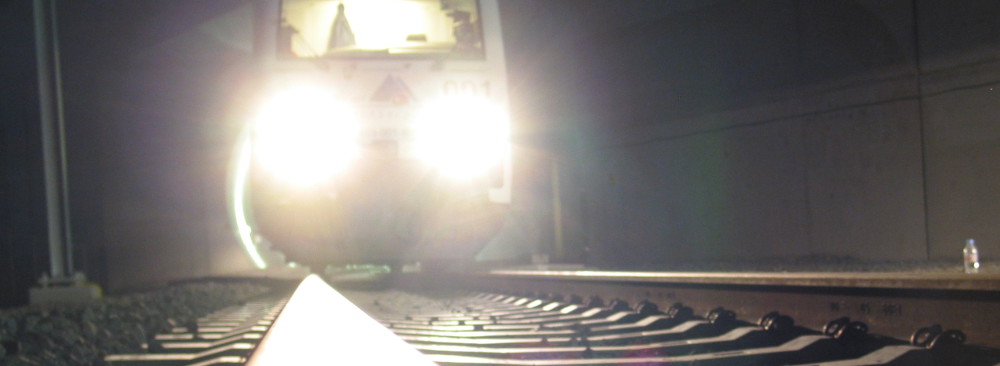On 3 December 2021, 24 IRSE Swiss section members and five guests visited the Appenzeller Bahnen (AB). The event was organised by Bruno Huber who has been involved as the external project leader on improving the infrastructure of AB. The Section had the opportunity to visit part of the improvements and to also see the special challenges a narrow-gauge railway company has in improving a service that passes through villages on their own tracks, and sometimes on tracks shared with road traffic.
The first part of the event was held in a classroom, where Roland Steingruber (head of infrastructure at AB), Thomas Graf (specialist of signalling at AB) and Bruno Huber gave some insight to the audience of AB and the special challenges of the project.
Appenzeller Bahnen (AB) is located in northeastern Switzerland and provides 6.3 million journeys every year on a network of 94km with 71 stations. The infrastructure also consists of 28 bridges and five tunnels. They are proud that AB operates the steepest adhesion traction in Switzerland having a gradient of up to 8 per cent. We visited AB specially to see the two projects Diameterline (DML) and the Teufen on-road cross-town link (Ortsdurchfahrt). Both projects belong to a bigger programme that will bring 15mins service interval from Teufen to St. Gallen. The programme will also reduce level crossings along the line and make significant progress in accessibility for people with disabilities.
The first site visited, Niederteufen, showed a few different level crossings with lights only or one arm barriers. Two level crossings protecting the two station tracks, where cars entering the main road must wait patiently on the double line under the arms, until the traffic is allowed to merge in. It was striking to experience how interwoven the track and the road are. A lot of properties have their own level crossing to enter their driveway – but the lights and bells are considered irritating especially late at night. Of course, the democratic stakeholder involvement process is aims to find the best solution for every party, a typical Swiss approach, which allows better overall acceptance for the solution.
The DML is already in operation. Major track relocation had to be done around St. Gallen main station and the Ruckhalde tunnel, 725m long, was built. Different types of points as well as different types of clearances were also a challenge.
The programme aims for completion by 2035. The whole line study initially considered more than 20 timetable variants. In consultation with multiple stakeholders including Federal Office of Transport, operational considerations and infrastructure management, the preferred solution for the whole line was found. As consequences some crossings must be moved, and in the section of Teufen, there will also be crossings in the on-road cross town section. This had multiple effects as the extension of the crossings and the addition of the tunnel Vögelinsegg added 90s, along with introducing a double line in Teufen.
For sections of the Teufen on-road cross-town link the operational rules will shift from ‘rail’ to ‘light rail’ rules due to 14 level crossings and of course the section where the train drives on the street. Further pillars of the programme are the station Teufen itself and the level crossing/roundabout to enter the station. To introduce the roundabout a whole house will be moved to make the required space available. The already performed project steps had to foresee further project development, so the already built interlocking had to allow for the extension of the cross-town link. The station itself should have the possibility to shunt trains to give access for passengers to the middle platform. The roundabout with a point in the middle and the next point right next to the footpath were for geometrical reasons. The cable pits and pipes had to have enough capacity for the cross-town link and had to be planned well in advance.
Some special challenges were around axle counters in the on-road section. During wintertime heavy snowfall and ploughing produced some ghost occupations. Additional axle counter logic would avoid this in a later phase.
The second site visited in the best winter weather was the station Teufen, taking the train 6 minutes uphill and revealed the real challenges. Making the left turn towards the church of Teufen allows the train driver to just see the signal for more than 6 seconds, which is the minimum signal sighting time mandated by the national regulations. Shortly after the signal there are two pedestrian crossings and a parking lot directly next to the track where cars drive in from the road crossing the track and reverse out backwards over the track again. The train driver needs nerves of steel coming around that corner! The beautiful station with the evening peak hour traffic on road and track, including pedestrians, shows that all parties need patience to let other traffic cross despite the combined signalling system.
A typical Appenzeller Dinner including the iconic “Bere-Schlorziflade” (pear tart) concluded the impressive evening. Many thanks to Appenzeller Bahnen for the excellent site visit and our organising team which created again a superb event.
